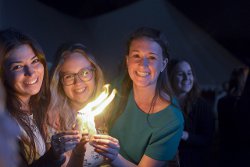 Iran’s Attack on Israel
Iran’s Attack on Israel


11 min read
Around the globe, people are once again joining the biggest global Jewish unity event the world has ever seen.
On the Shabbat of October 23/24, 2015, Jewish people will gather once again in hundreds of cities around the world for the international Shabbat Project. The concept is simple: Jews of all walks of life, from across the spectrum – religious, secular and traditional; young and old, from all corners of the globe – uniting to experience one full Shabbat together.
Last year, around one million people in 465 cities and 64 countries took part – not just in unique Shabbat programs, but in city-wide pre-Shabbat Challah Bakes and post-Shabbat Havdallah Concerts. An untold number observed Shabbat in full for the first time in their lives.
Last year, around one million people in 465 cities and 64 countries took part.
“Even in our most optimistic moments, we could never have imagined the depth and breadth of the response,” says the project’s architect, South Africa’s Chief Rabbi Dr. Warren Goldstein. “It was thrilling and inspiring to witness Jews from across every conceivable divide – language, culture, ethnicity, geography, observance – viscerally embrace The Shabbat Project and make it their own.”
The stories, both big and small, that emerged in the aftermath were extraordinary.
 A lone Jew in an Arkansas town felt an overwhelming sense of camaraderie with Jews around the world “keeping it together” alongside him. Viviana Tarrab, amidst a crowd of nearly 5,000 at the Buenos Aires Challah Bake, witnessed four generations of her family “kneading it together.” A group from Gateshead defied a hundred years of division and antipathy, crossing the river Tyne to share a Shabbat meal with their counterparts in Newcastle.
A lone Jew in an Arkansas town felt an overwhelming sense of camaraderie with Jews around the world “keeping it together” alongside him. Viviana Tarrab, amidst a crowd of nearly 5,000 at the Buenos Aires Challah Bake, witnessed four generations of her family “kneading it together.” A group from Gateshead defied a hundred years of division and antipathy, crossing the river Tyne to share a Shabbat meal with their counterparts in Newcastle.
There were the ten Jewish girls from a private Episcopal school who attended the Miami Challah Bake – their first-ever Jewish experience. There was the first-time Shabbat dinner guest, who, running late and hitting traffic, parked his car and walked eight miles to attend a Friday night meal. There was the Hoff family of Golders Green, London, who hosted 100 people for lunch in a big tent in their garden, and the Nissim family hosted a full Shabbaton in their house for 150.
Street dinners in Johannesburg sat up to 1000 people at tables stretching for almost half a kilometer, while a Perth mother had 25 of her son’s mainly non-observant classmates around the Shabbat table – alongside an eighth-generation Jerusalemite, four secular IDF soldiers, a recently converted Danish gentleman, and three Israeli travellers fresh from the Aussie outback.
 At a bake in Abuja, Nigeria, 21 women prepared challah. In Angola, 40 Jews got together for a Friday night service, Kiddush and meal. A synagogue in São Paulo that normally seated 30 people hosted 712.
At a bake in Abuja, Nigeria, 21 women prepared challah. In Angola, 40 Jews got together for a Friday night service, Kiddush and meal. A synagogue in São Paulo that normally seated 30 people hosted 712.
And everywhere, Jews of different backgrounds and levels of observance connected at Challah Bakes and Havdallah Concerts, and around Shabbat tables, like never before.
“We saw the possibility of transcending all the barriers and differences that seem to separate us,” says Goldstein. “Over the course of just one Shabbat, all of that melted away.
“Ultimately, The Shabbat Project showed us new, glorious possibilities for what we as a people and as individuals can attain – that we can overcome the divisions of the past, reclaim our spiritual heritage, even become better people.”
Many of today’s leading behavioral scientists, neurologists, psychologists and social commentators point to a “crisis of attention” in the digital age – a world that has become a constant feed of information and entertainment, a procession of beeps and pings and pop-ups doing battle for our attention. “A world in which we are so besieged by distractions,” says Goldstein, “we’ve forgotten how to live.
Innumerable studies show serious harm being done to relationships, social skills, concentration levels, physical memory, physical wellbeing, even our ability to feel. And almost invariably, the solutions put forward – more face-to-face time, digital detox, slowing down, taking a nap, going for a walk, deep breathing, self-reflection, distraction-free meals around the table – point in the direction of Shabbat.
Shabbat holds a special power and resonance in today’s world.
“A unique tranquility and intimacy permeates our homes on Shabbat,” says Goldstein. “No one has to answer the phone or rush off. No one is distracted by the screens of information and entertainment that saturate our world. We are left with a remarkable, uninterrupted haven of love and connection, which allows us to appreciate and focus on what we have in our lives.”
Shabbat, Goldstein believes, holds a special power and resonance in today’s world.
 “It enables us to momentarily set aside the distractions, demands and pressures of daily life – offering us the time and space to renew our inner selves, and to revisit and reinvigorate our most important relationships. Shabbat can hold us together in a society where everything seems to be pulling us apart.”
“It enables us to momentarily set aside the distractions, demands and pressures of daily life – offering us the time and space to renew our inner selves, and to revisit and reinvigorate our most important relationships. Shabbat can hold us together in a society where everything seems to be pulling us apart.”
Crucially, The Shabbat Project is not merely about performing a symbolic gesture to acknowledge Shabbat – it involves keeping it in full. For Goldstein, authenticity is everything.
“This approach is predicated on the idea that the real energy of Shabbat – its transformative power – is wholly dependent on immersing oneself in the full Shabbat experience.”
One of the unique aspects of The Shabbat Project is that all factional identities – all denominations, affiliations, ideologies, and political differences – are put aside.
Laurence Horwitz, the project’s Creative Director, calls it “real Jewish unity, built from the ground up.”
 Horwitz points out that while The Shabbat Project is coordinated and managed through formal communal organizations and partners, the initiative is essentially a grassroots social movement – “by the people for the people”.
Horwitz points out that while The Shabbat Project is coordinated and managed through formal communal organizations and partners, the initiative is essentially a grassroots social movement – “by the people for the people”.
“Jews across the spectrum are receptive to it precisely because it isn’t associated with any particular movement or body,” he explains.
The significance of this should not be underestimated. As Horwitz observes, genuine Jewish unity has proved a stubbornly illusive ideal.
“I think, to some extent, the Jewish world has been at somewhat of a loss what to do,” he says. “We’ve seen Jewish unity become something of a pipe dream, an unobtainable utopia. But The Shabbat Project has reminded us that it needn’t be.”
This year, communities around the world are gearing up for a Shabbos that could well eclipse last year’s event.
Perhaps the clearest indication of this is the fact that the partner network has snowballed from 1,800 to more than 5,000 dedicated volunteers, who will now be bringing The Shabbat Project to around 550 cities and counting. Among the new, “exotic” locations being pinned to the Jewish Map in 2015 are Maui (Hawaii) Kuala Lumpur (Malaysia), Srirangapatna (India) and Puerto Iguazu (Argentina).
“What we continue to see are new, interesting communal dinner ideas, innovative educational programs run by shuls and schools, individuals who have a crazy idea and just run with it… it’s really exciting,” says Rosy Hollander, international Project Manager for the Shabbos Project.
Israel is one of the big stories this year, with the Jewish State primed to take its place as the global hub of The Shabbat Project.
Mayors and municipalities throughout Israel have got behind The Shabbat Project. Meanwhile, Hatzofim and Bnei Akiva – the country’s two biggest youth movements – are sending tens of thousands of their members into the field to arrange Shabbat dinners and activities, and will hold joint Kabbalat Shabbat services. (That these two very distinct movements are putting aside any ideological differences and joining forces to bring the Shabbat experience to Jews all over the country exemplifies the spirit of The Shabbat Project.)
Meanwhile, government agencies, NGOs and civil society groups across the spectrum are also on board. Student organisations are arranging Shabbat events for thousands of students at Israeli universities; Hesder are marshalling over 2,000 yeshiva students/soldiers serving in army bases around Israel to arrange Shabbat dinners and other events; and the Jewish Agency are bringing together thousands of new immigrants for challah bakes and Shabbat meals at the country’s absorption centres.
In Tel Aviv, 3,000 women are expected at a Challah Bake, including 400 from all over the world on the JWRP (Jewish Women’s Renaissance Project) trip, while Racheli Fraenkel will be presiding over a similar event at the Tachana Harishona in Jerusalem. Tel Aviv will also be hosting “back to basics” Friday night picnics on Rothschild Boulevard and Kikar Hamedina, while the mayor of Sderot is hosting a communal dinner for 1,000 people; the mayor and chief rabbi of Netanya will be uniting for a special tisch; and Tzfat, where Shalom Aleichem and Lecha Dodi were written, will be hosting a city-wide unity Kabbalat Shabbat service.
The US is a similar hive of activity. After the extraordinary impact of The Shabbat Project last year in Miami, San Diego, Dallas and scores of cities across the US, this year is seeing the major Jewish metropolises of New York City and Los Angeles come to the fore.
LA will be hosting a Friday night Shabbat dinner billed as one of the biggest in history. The organisers will be closing down Pico Boulevard to accommodate the more than 3,000 people expected to attend.
Similar numbers are anticipated at a Challah Bake in New York’s Grand Prospect Hall, where there will be an attempt to set a new Guinness World Record for the world’s largest braided challah.
Meanwhile, Baltimore is gearing up for a Challah Bake at the Maryland State Fairgrounds at which 4,500 women and girls are expected (last year’s event drew a still-sizeable 1,200 participants). The organizers have already secured 6,750 pounds of flour, 1,575 pounds of sugar, 730 pounds of vegetable oil, 750 dozen eggs, 11 pounds of salt, 4,500 packs of yeast and 450 gallons of water for the occasion.
In South America, Buenos Aires is once again shaping up as one of the biggest Shabbat Project participating cities in the world. Between 3,000 and 4,000 women are expected at the Buenos Aires Challah Bake, and it remains to be seen whether they can match the record 13,000 people that showed up for last year’s Havdallah Concert. The team will soon release a special Shabbos Project theme song (featuring local Jewish music stars). Elsewhere in South America, 3,000 people are expected at a Havdallah Concert under the stars in Santiago, Chile, which will feature a local children’s choir, and Panama have unveiled a colorful matchbox campaign to encourage Jewish women across the country to light Shabbat candles.
But arguably the most “out there” Shabbat Project event will be taking place on the “rooftop of Africa”, 13,000 feet above sea level. It involves a group of 28 public-spirited adventurers from Israel, the US the UK and Canada, who are summiting Mount Kilimanjaro in Tanzania to raise funds for SHALVA, the Association for Mentally and Physically Challenged Children in Israel. Four days into the eight-day trek, the group will set up camp at Barranco Wall, where they will bring in Shabbat with Jews worldwide taking part in The Shabbat Project.
“In 2014, we saw a vast and energetic social movement suddenly sprung up, as people spontaneously came forward to take ownership of The Shabbos Project and brought it to life,” says Hollander. “While last year’s participation was extraordinary, this year presents the opportunity to build on those foundations – to take this initiative to truly (in one case, literally) unimaginable heights.”
The Shabbat Project has been described as “the most ambitious Jewish identity initiative ever undertaken” and "an experiment that has no precedent in modern Jewish history”.
Yet the appeal, for many, lies in its simplicity.
“The Shabbat Project is an opportunity for the entire Jewish world to keep one complete Shabbat together – from Friday evening just before sunset on October 23, until Saturday night after the stars have come out, on October 24,” says Goldstein.
“The beauty of this is that it is so practical and manageable. After all, it’s only one Shabbat. It’s something everyone can do.”
The Shabbat Project will be taking place this year on October 23-24, in more than 550 cities and 65 countries around the world.
